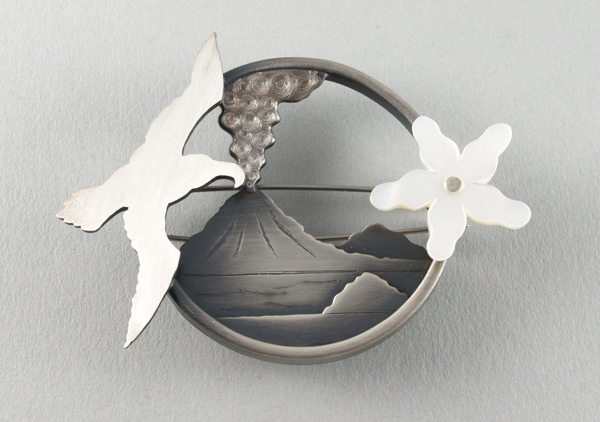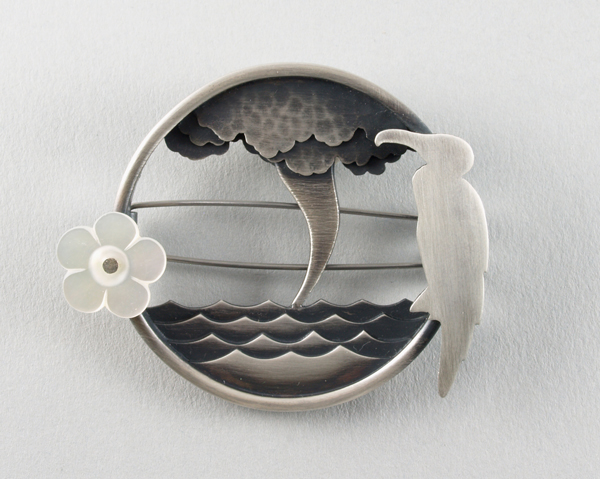
Susan Cummins: Please tell the story of how you both decided to show together in the exhibition at Quoil?
Lisa West: We shared a workshop for years and we’re good friends, so it seems natural to me that I approach Tania about doing the occasional show together. We have shown together previously at Quoil. We often work independently on quite similar things without realizing it, so I think we make things that are quite cohesive when they’re displayed together.
Tania Patterson: Lisa and I are old friends. We have shown together in the past, and it seemed about time we did it again. We seem to work on similar themes, and our work sits well together.

Susan Cummins: Please tell the story of how you both decided to show together in the exhibition at Quoil?
Lisa West: We shared a workshop for years and we’re good friends, so it seems natural to me that I approach Tania about doing the occasional show together. We have shown together previously at Quoil. We often work independently on quite similar things without realizing it, so I think we make things that are quite cohesive when they’re displayed together.
Tania Patterson: Lisa and I are old friends. We have shown together in the past, and it seemed about time we did it again. We seem to work on similar themes, and our work sits well together.
Why did you call it Salty?
Lisa West: Tania thought of the title. I had another title that I’ve completely forgotten as I liked Salty so much. It has the obvious allusions to the sea, but I also quite like it because it’s slightly abrasive, and it has the other definition of being earthy, vigorous, or lively. I quite like that as we’ve both made work that is willfully narrative and representational. It’s a style of work that I think has a tendency to be somewhat overlooked at the moment for not being clever enough or maybe just being too obvious. I think maybe we both like messing around in rock pools …
Tania Patterson: We both happened to be working on ideas to do with the sea. After kicking a few ideas around, we decided on Salty. We liked the broadness and ambiguity.

Can you each tell me how you decided to become a jeweler?
Lisa West: I was 19 and not doing anything very constructive with my life, so my mother decided that signing me up for a one-day-a-week jewelry-making course at Hungry Creek craft workshops (as they were known at the time) was a better option for me than doing nothing. Andrew Venter at Hungry Creek was very supportive and found a way for me to attend full time. I’d always enjoyed making things, so I just kind of fell into it. It wasn’t a conscious choice at the time.
Tania Patterson: I studied a range of crafts as part of my diploma in craft design back in the 1980s. I settled on jewelry in my final two years. I love the scale and intricacies as well as huge range of techniques and processes. There is always something new to learn.

Lisa West: I’ve been making a modest living by making jewelry full time since the mid-90s. It’s been more difficult in the past few years because of the economic conditions, but I’m looking at using my metal skills to move into related areas. I’m interested in doing more product design, and I’ve also been working with wax and getting pieces cast, so I’m getting enthusiastic about small metal sculpture, too. It’s a matter of finding the right people who know how to do things better and more efficiently than I can. I do think that retail is in a difficult transitional phase at the moment because of the explosion of Internet shopping sites, but I’m enormously grateful to the galleries that support and promote their artists. Mainly, I have a very tolerant husband who works in IT!
Tania Patterson: Yes, I make a living though not a very good one. I was self supporting until I had my daughter seven years ago and my hours became greatly reduced. My husband is a builder and brings in the bulk of the income nowadays. We live a pretty simple rural life, and I don’t know that I could manage if I was still renting a studio in Auckland.

Lisa West: I think that New Zealand jewelry used to have a distinct look to it, but that has changed in recent years. I think that, as more relationships have been forged with European galleries and international showcases, there has been a tendency for New Zealand contemporary jewelry to become more generic and globalized. I also think that we have access to so much information and so many images now at the click of a button that influences come from all over the globe. The materials that were previously associated with New Zealand jewelry aren’t so much in evidence now, either.
Tania Patterson: Ten years ago, I would have said yes, definitely. Now, I am not so sure. There used to be a real sense of place, of the New Zealand landscape and natural environment. There was a lot of use of organic materials in combination with metals. Now, I see a lot more ephemeral works that use plastics and less durable materials, and they do not speak to me of New Zealand, but perhaps I am just a bit old school.
Please describe how your studio looks and a typical day working.
Lisa West: My workshop is a really nice space in our house with big windows and sliding doors and views out into the bush, so there’s often something interesting going on bird-wise, especially in tui season. Inside, it’s often quite messy, as I’m not a tidy worker, and I’ve got my stone-cutting, bead-making, and metal-working tools all jammed in together. I like to go for a walk and a coffee before work, as it can be isolating working alone. I’ve lived in Birkenhead for so long now that I know lots of my fellow pedestrians, so often work doesn’t start until about 10:00am. I’ve usually got a written list of tasks to achieve for the day, and I just try and work my way through them. I like to have a few different things on the go simultaneously.
Tania Patterson: My studio is a converted skyline garage. My bench sits against the ranch slider, and I have views out over our paddocks with horses out to distant sea views with Whangarei Heads on the horizon. I have two benches, one for metals and the other for carving wood and other materials. I have a second room where I do all the dirty stuff—polishing, shaping, and sanding work and any sculpture projects.
My day starts with getting my daughter onto the school bus at 7:40am (always a mad panic). I am in the studio by about 8:00am and could be doing a number of things—cleaning up castings, painting details on pohutukawa leaves, drawing ideas for new work, carving pod centers. Three o’clock comes around pretty quick, and I meet my girl off the bus and work finishes for the day.

Lisa West: If it’s a brand new idea or technique, I almost have to get a bit psyched up before getting down to work. Sometimes I play around with test pieces. I never draw anything unless it’s an engineering problem to solve or I need to makes some templates to trace around. It’s best just to jump in and not procrastinate too much.
Tania Patterson: Well, I still draw, but it has become quite rudimentary. It depends a bit on what the new work is. Some pieces grow out of techniques, and I work in rather an intuitive way and enjoy making a series forms that please me. Other times, I research things on the Internet, especially when I am making birds or animals and want the details to be correct.
What have you been read, seen, or heard lately that you can recommend?
Lisa West: I’m a big reader. I probably visit my local library at least a couple of times a week, so I’ve definitely got some books I’ve just read to recommend. I’ve just finished reading a couple of books by American author Dan Simmons, The Terror and The Abominable. He writes grippingly about very cold places and the effect of extreme conditions on humans pushed to their physical and mental limits in both these books, and I also loved reading The Luminaries very recently, which leads me onto Liam Barr. His latest painting show at Artis called Lore and Behold was fantastic, and I imagined his paintings illustrating The Luminaries as I was reading it. His work is a sort of narrative mythology of historical New Zealand. He has a very rich visual language that I admire. I love it, and I want one! I recommend listening to anything by Marlon Williams and Delaney Davidson. Marlon sings like an angel, and Delaney sounds like a snake-handling Jesus-jumping old-timey preacher. Perfect combination.

In thinking more about interesting things I had seen lately, I thought I would recount this story to you. A group of us did a beautiful bush walk on Monday. It is a newish walk in Mangawhai and runs up a valley in the Brynderwyn range. The track follows a pretty stream, and there are lots of pools and then a couple of waterfalls. We were going to visit the big old eel that live in the first of the waterfall pools. This was my second time visiting the eel, so I had come prepared with some mince. The first time I met the eel, the kids had been playing in the icy cold water, and there was much squealing, and then they all came rocketing from the pool screaming, “shark!” I thought them rather hysterical, but then I saw the big eel roll over. He is probably about a meter long and as thick as my upper arm. To our amazement, he swam into the shallows, and the kids fed him bread. On this latest trip, I put some mince in the water and waited. Nothing happened. At last, he came swimming upstream and through the rocks. The kids fed him mince off the end of little sticks. It was quite a magical experience to have that kind of interaction with a wild creature.
I am sure it is fairly obvious that it is encounters with nature that inform much of my work, be it exploring rock pools, gathering leaves of different shapes, or watching the native birds in my garden. About a zillion years ago, I was in America at an artist’s talk. She showed us slides of a work where she had seen an old house with the cladding removed and all the black building paper exposed. She had spent weeks cutting patterns into the building paper. A neighbor came and asked her why she was doing it, and she replied, “to see what it looks like.” He said, “That’s a whole lotta work for just looking.” This has stuck with me, as I sometimes feel I am a bit mad and self indulgent in the compulsion to make something that may consume lots of time (and may very well not work out) just to see what it will look like. But, there seems no other way.
Thank you.




